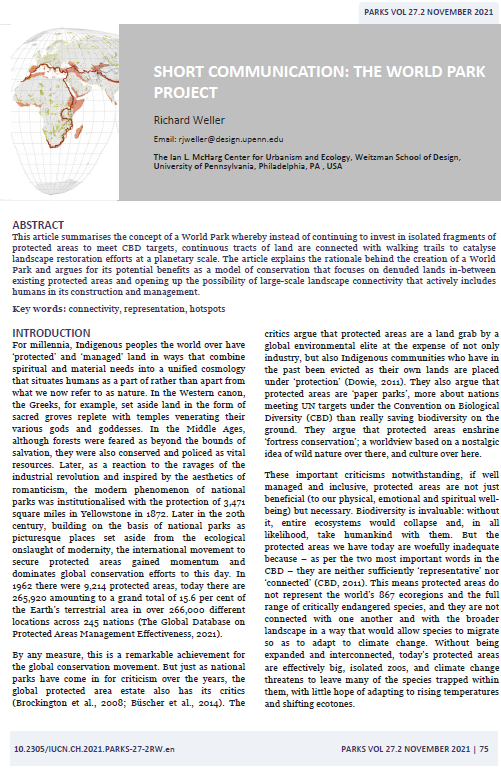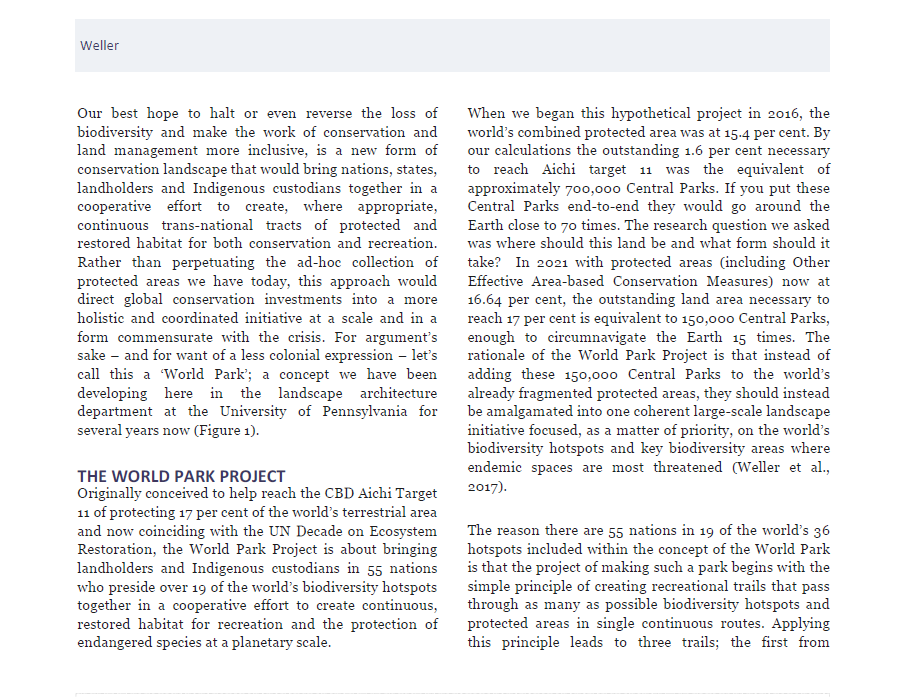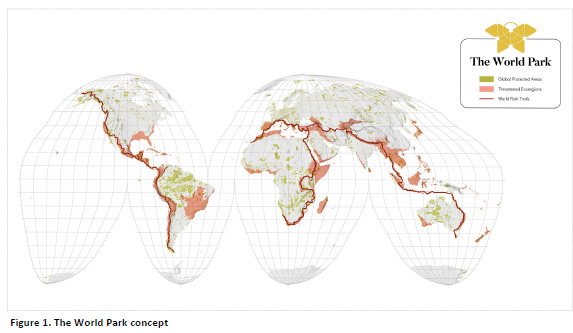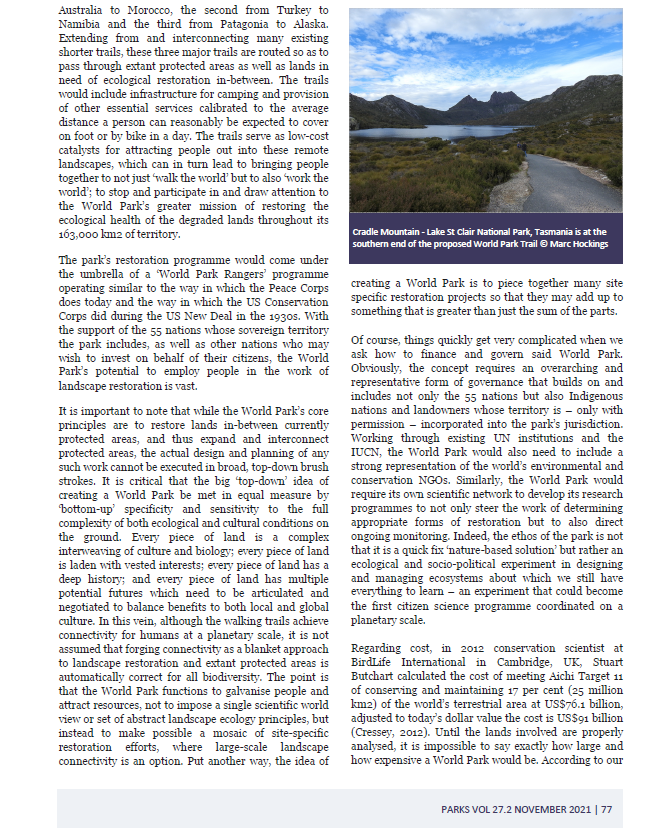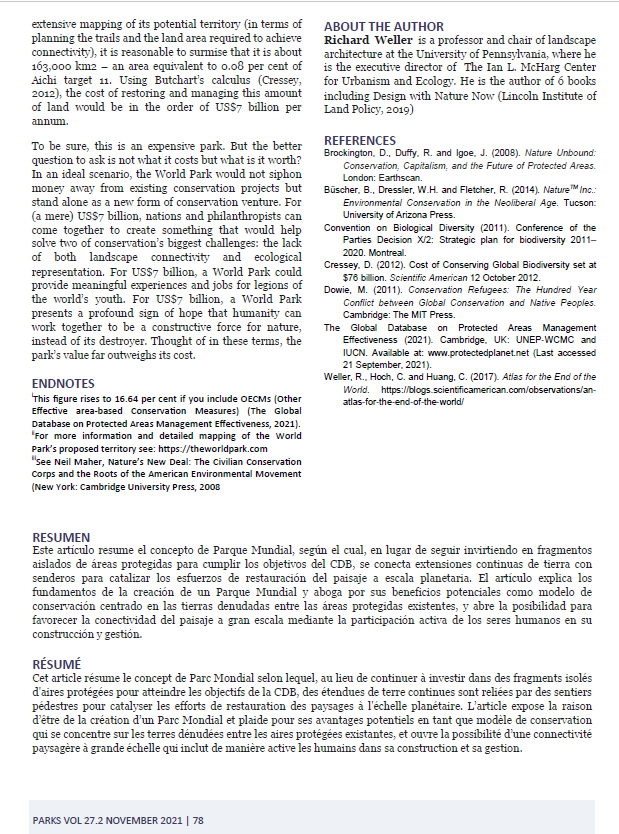Answers to Self Assessment — Is This Plagiarism?
These are the answers to the questions in the section of this workshop titled “Self Assessment — Is This Plagiarism?”.
After you come up with your own answers to the questions, then use these answers written by the librarian to check your understanding.
Student Essay Example 1 Answer
Student Essay Example 1 is Plagiarism. It would be Find-Replace plagiarism.
The essay example below is re-formatted to show you where the problems are. The first part of the first sentence of the paragraph is the student’s own analysis and we put it in italics font to draw your attention to it. Unfortunately, the rest of the paragraph are statements the student took directly from the research source and then re-phrased by changing the words so that it means the same thing but might be harder for a professor to recognize as plagiarism.
In this case, the professor would likely be suspicious because of the fact that some of the words that the student selected to replace the original words are awkward or unusual. The awkward words are in bold to draw your attention to them below.
The student could have avoided this Find-Replace plagiarism by mentioning that this information about highways and access to California National Parks comes from a research source. Then they could paraphrase the ideas in the source by explaining them in their own words and not be plagiarizing at all. The text that the student paraphrased would be followed by an in-text citation, which we said more about in the sections of this workshop titled “Mark the Boundaries When Writing Your Draft” and “In-Text Citations and Citations at the End”. The in-text citations we added are underlined to draw your attention to them.
The popularity of the various National Parks in California can vary depending on how close they are to highways and sometimes freeways have been engineered to enhance egress to isolated locations of the National Parks (U.S. National Parks). In one case, the freeways around Yosemite Valley join the Park to the populous Central Valley and have resulted in the Yosemite Valley itself being built-up to support hordes of tourists (U.S. National Parks).
Student Essay Example 2 Answer
Student Essay Example 2 is Not Plagiarism. The student starts the paragraph with their own idea and they end the paragraph with their own analysis. They use the research source to provide evidence that they would not have known without reading about it and they clearly mark the information they get so that they show the boundary between their ideas and the ideas they got from the research source. The text that is in parentheses, (U.S. National Parks), is the in-text citation, which tells the reader exactly which information came from another source and what that source was. The full information the reader would need to use to find the research source is put at the end of the essay in the Works Cited or References.
Student Essay Example 3 Answer
Student Essay Example 3 is Plagiarism. It would be CTRL-C plagiarism.
The essay example below is re-formatted to show you where the problems are. The student is making their own point at the beginning of the paragraph but then they drop in a sentence from the research source, which is in bold to draw your attention to it. Because the student didn’t put any boundaries around the sentence from the research source, it would appear to their reader that the student wrote it themselves. Since it seems like they’re trying to pass off the sentence from the research source as their own work, the student is plagiarizing. The student could have avoided the CTRL-C plagiarism by putting quotation marks around the sentence and including an in-text citation at the end.
Visiting the National Parks that are located in California is a great way to appreciate the natural landscape and to take a break from the hustle and bustle of the typical tourist attractions. But you might be surprised about which parks draw a big crowd. The offshore Channel Islands have remained remote, as have the Pinnacles, while Death Valley is a popular destination despite its distance from cities.
Student Essay Example 4 Answer
Student Essay Example 4 is Plagiarism. It would be Remix plagiarism.
The student has combined ideas from multiple sources without showing where they came from. As a reader who is not familiar with the sources, it would be hard for you to tell that the student is Remixing. In fact, they are using the Wikivoyager US National Parks source as well as a source called “National Parks: Can ‘America’s Best Idea’ Adjust to the Twenty-First Century?” which we also used in the workshop section titled “Paraphrase the Right Way”.
It’s important to synthesize from multiple sources in your college essays, so using information from a variety of research sources is a good idea. In order to avoid plagiarism, though, you have to put the in-text citations for the sources each time you mention an idea from one of them. In the example below, we have added the narrative and parenthetical in-text citations and underlined them to draw your attention to them. Here’s how Student Essay Example 4 should look with the sources cited to avoid plagiarism:
The National Parks in California are often judged on how crowded they are or how pristine, on how convenient they are to access or how remote. To increase the use of National Parks like Yosemite, highways have even been built around them and amenities have been developed for tourists (U.S. National Parks). But the National Parks in California should also be judged for how well they help the community to engage with the complex stories about how the land used to establish the parks was only available because of the “violent removal of Indigenous populations” (Nunnally). Teaching the public this type of information about the National Parks may be considered controversial by some, but scholar Patrick Nunnally points out it “brings American Indians back into the ‘national story’ that it tells in the parks, that effort opens the way for inclusion to become the default mode for understanding the populations of the country.” This can lead to even deeper connections to the land and to each other than a simple hike in the wilderness can accomplish.
Text version of the Example of PQC Notes image
In this example of PQC Notes, the student set up a table for their notes. Across the top of the table, the student wrote the author and title to label their notes. The author is Weller and the article title is The World Park Project. You have access to this article in your workshop book.
In the section labeled P for Paraphrases, the student wrote “This article is about creating three trails (like the P.C.T.) that connect biodiverse areas across countries to centralize conservation efforts.
In the section labeled Q for Quotes, the student wrote “Pg 77 ‘…the idea of creating a World Park is to piece together many site specific restoration projects so that they may add up to something that is great than just the sum of the parts.”‘
In the section labeled C for Comments, the student wrote “Interesting concept. It makes me think of the Pacific Crest Trail (PCT) that goes through CA-OR-WA. Could some of the ways the PCT was created inform how the “World Park” could work?
Examples from Paraphrase the Right Way
In the section of this workshop titled “Paraphrase the Right Way”, you read an example of an unacceptable paraphrase. Here is a corrected Version of the Student Paraphrase Example 1 — In Student Paraphrase Example 1, if the student quoted the exact phrases and added in-text citations, they would have avoided plagiarism, though most professors would probably have a concern about the student quoting so much instead of paraphrasing by explaining the ideas in their own words to show that they understand them.
According to Patrick Nunnally, a scholar of river life, the National Park Service (NPS) can “create genuine collaboration with Indigenous communities” by acknowledging “that many of the iconic large Western parks were created through the violent removal of Native populations.” The NPS calls their collaborations with American Indians “civic engagement” and these are part of the NPS effort to address the “complex stories about the country’s past that are still controversial” (Nunnally). This may not be what “many traditional park users seek,” since they probably prefer a positive narrative at NPS sites, “where conflict and difficulty are all in the distant past” and everything “turns out well in the end” (Nunnally). The NPS instead are “developing new interpretations at longstanding sites” and as the NPS “brings American Indians’ experiences back into the history that it tells in the parks,” I argue “that effort opens the way for inclusion to become the default mode for understanding” the true story of the country (Nunnally).
Text Version of Anatomy of an Outline
In the Anatomy of an Outline image, created by Kwantlen Polytechnic University, the Thesis Statement is the focus for the outline. The Thesis statement is: Because globalization is an undeniable reality in today/s world, a well-rounded Canadian education must include opportunities for students to study one or more languages.
The first main point of the outline is 1. Bilingualism is the norm for most of the world’s people. Those who are not bilingual are easily left behind.
The supporting points and evidence for the first main point are: 1. Statistics on bilingualism in the world. 2. Contrast between levels of bilingualism in Europe, Asia, and North America. 3. Disadvantages created by low levels of bilingualism in Canada.
The outline includes four main points and there are two or three supporting points and evidence for each main point. In the outline you write, each supporting point should have citations for the sources where you found the evidence that you will use in your essay.
Research Source Excerpts Used in “Mark the Boundaries When Writing Your Draft”
We used the following excerpts for the examples in the workshop section titled “Mark the Boundaries When Writing Your Draft”.
From page 12775 of the research source: Management requires capital to ensure visitors’ health and safety and to maintain infrastructure and services that facilitate desired outdoor recreation activities. Importantly, capital is also required to take management actions that minimize the environmental disturbance visitors can have on natural landscapes and cultural resources. As the demand for outdoor recreation continues to grow across the country, so too do the costs associated with managing outdoor recreation destinations.
Visitation to parks and protected areas across the United States has increased substantially over the past half-century; despite slight declines in the 1990s and early 2000s, many parks are now experiencing record high visitation (1, 2). This has led to many well-publicized claims that the nation’s national and state parks are being “loved to death.” Annual visits to the nation’s national parks, for example, increased by 33% from 1984 to 2017.
From page 12778 of the research source: Our investigation determined temperature, but not precipitation, is positively related with operating costs. Over the past 34 y, we estimate that for every 1% increase in annual mean temperature, America’s state park systems have seen an $11.51 increase in operating expenditures per acre. We found the operating expenditures of state park systems at lower latitudes are more sensitive to increases in temperatures relative to those at higher latitudes. This is likely attributable to the fact parks in warmer climates are more costly to manage (15). While this is true, the more rapid rates of warming expected at northern latitudes (16) may result in warming having a larger actual impact in northern states. […] While operating expenditures are expected to increase substantially under any of the plausible future climate scenarios, the magnitude of these increases are small relative to those expected under a scenario in which historical attendance trends (1984–2017) persist until mid-century. Under this scenario, operating expenditures would reach $47.88 billion by 2050.
Citing Sources Decision Chart
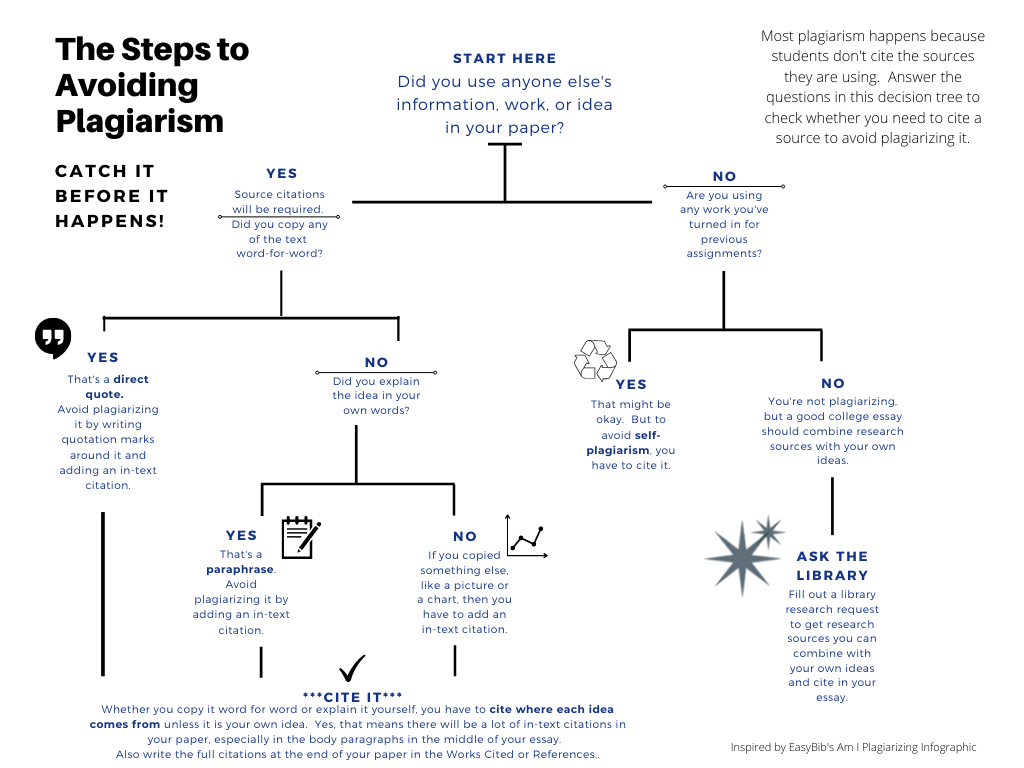
Text version of The Steps to Avoiding Plagiarism
Catch plagiarism before it happens by asking yourself questions along the way.
Most plagiarism happens because students are not citing the sources they are using. Answer the questions in a decision tree to check whether you need to cite a source to avoid plagiarizing it.
First answer the question: Did you use anyone else’s information, work or idea in your paper?
Choose YES or NO.
YES. Here’s what to do if you answered Yes, you used someone else’s information, work, or idea in your paper:
Ask yourself if you copied any of the text from a source word-for-word.
If you did copy text from a source word-for-word, then that’s a direct quote. You have to put quotation marks around the quote and provide an in-text citation and a full citation.
If you did not copy text from a source word-for-word, then ask yourself if you explained the ideas from the sources in your own words.
If you did explain the idea in your own words, then you have paraphrased the idea and you have to provide an in-text citation and a full citation.
If you did not copy word-for-word and if you did not explain the idea in your own words, then you may have copied something else from your source, like a picture or a chart. If you copied something from a source, even if it is not words, then you have to provide an in-text citation and a full citation.
NO. Here’s what to do if you answered No, you did not use anyone else’s information, work, or idea in your paper: Ask yourself if you are using any of your own previously submitted work in the paper you’re writing now.
If you are using just a little information from your own previously submitted work, then you can cite yourself.
If you want to use a lot of information from your own previously submitted work, then you have to get permission from your current professor and from the professor in the class where you originally submitted your work. If both agree that it’s okay to reuse a lot of what you wrote before, then you can do that without plagiarizing.
If you are not using any ideas from other sources and you’re not using anything from your previous work, then you are not plagiarizing, but you might be missing an important assignment requirement to do research to find evidence and examples before writing your essay. If you need research sources but you don’t have them, then contact the librarians for assistance.
Remember that whether you copy it word for word or explain it in your own words, you have to cite where each idea comes from unless it is your own idea. Yes, that means there will be a lot of in-text citations in your essay, especially in the body paragraphs in the middle of your paper.
Return to the Image of The Steps to Avoiding Plagiarism in the section titled “When to Cite”..
Text version of In-Text Citation Highlights
This paragraph is used in the image to show in-text citations. Below the paragraph is our explanation of the highlighted citations.
Veterans dealing with bodily injury, traumatic brain injury, and post-traumatic stress disorder face significant barriers to treatment. Disabled veterans returning from Iraq and Afghanistan wait an average of to six months for their claims to be processed, and the appealing a rejected claim takes an average of five years (Katel 361). The Bush administration underestimated the cost of caring for veterans of the wars in Iraq and Afghanistan, and the federal government has since been playing catch up funding departments such as Department of Veterans Affairs (“Senate”). In addition, Lawhorne-Scott and Philpott point out that sometimes veteran’s “feelings of guild or self-blame cause much distress and can prevent a person from reaching out for help” (117). Peter Katel’s report on veteran care concludes that veterans’ needs are on-going and extensive, and addressing those needs will require a shift in national priorities (379).
Explanation of the in-text citations:
Each sentence from the excerpt that included an in-text citation is listed below. After the sentence, we explain the type of in-text citation it shows.
Disabled veterans returning from Iraq and Afghanistan wait an average of to six months for their claims to be processed, and the appealing a rejected claim takes an average of five years (Katel 361).
The in-text citation in this sentence is (Katel 361). This shows the reader that the information in this sentence came from a source by an author named Katel and that the information was on page 361 of the original source.
The Bush administration underestimated the cost of caring for veterans of the wars in Iraq and Afghanistan, and the federal government has since been playing catch up funding departments such as Department of Veterans Affairs (“Senate”).
The in-text citation in this sentence is (“Senate”). This shows the reader that the information in the sentence came from a source with the title Senate and that the source did not have a named author or a page number.
In addition, Lawhorne-Scott and Philpott point out that sometimes veteran’s “feelings of guild or self-blame cause much distress and can prevent a person from reaching out for help” (117).
In this sentence, the authors are mentioned as part of the introduction for the direct quote from the original source; their names are Lawhorne-Scott and Philpott. The quotation marks before “feelings… and after …help” show that those are the exact words that Lawhorne-Scott and Philpott used in their book. The sentence ends with (117) to show that the quote came from page 117 of the source.
Peter Katel’s report on veteran care concludes that veterans’ needs are on-going and extensive, and addressing those needs will require a shift in national priorities (379).
This is another example of the author being named in the sentence to give context to the paraphrase. Although the student did not use Katel’s exact words in this sentence, they still need to cite Katel because they paraphrased him. The sentence ends with (379) to show that the paraphrased information came from page 379 of the source.
Return to the Image of In-Text Citation Highlights in the section titled “When to Cite”.
Answers to Self Assessment — Test Your Knowledge and Skills
These are the answers to the questions in the section of this workshop titled “Self Assessment — Test Your Knowledge and Skills”.
After you come up with your own answers to the questions, then use these answers written by the librarian to check your understanding.
Each correct answer is worth one point. A good score on this self-assessment is 10 correct answers.
1. A student copies a paragraph from a source directly into their own essay without changing it. What type of plagiarism is this?
- CTRL-C
This is CTRL-C plagiarism because the student copied from the source.
2. A student gathers ideas from several sources, explains the ideas, adds their own analysis, and cites all of the sources they used. What type of plagiarism is this?
- It is not plagiarism
This is not plagiarism because the student did not use sources to replace their own work and thought. Instead, they engaged with the sources to learn more about the topic, come up with their own ideas, and show their reader what parts of their essay were from the sources and which were their own ideas.
3. A student finds useful ideas and facts in a research source and uses their own words to write about them, but does not mention the original source in their essay. What type of plagiarism is this?
- Find-Replace
Because the student didn’t show their reader that some of the ideas in their essay were coming from research sources, they are plagiarizing. Some students explain a source in their own words to try to hide that the idea came from somewhere else, but paraphrasing and citing a source is always a good idea so that your professor can see what you learned from your research and see that you did the work of researching your topic. Because the student only used one research source this would be Find-Replace plagiarism. If a student used multiple research sources this would have been Remix plagiarism.
1. In an article you find the unusual phrase “cultural tapeworm.” You decide that it’s a great way to describe an example you are using in your essay, so you use it.
- You have to cite it
Since the phrase is not a common one, the original author deserves credit for thinking of it. You could cite this by writing something like: Robert Harris describes people who write movie reviews for a living as “cultural tapeworms” (138). The image of a “cultural tapeworm”, feeding on us to enrich themselves, seems even more appropriate to describe Tik Tok influences, who take whatever they see and repackage it to get sponsors.
2. You read in several sources that the majority of Americans have smartphones. You mention in your essay that smartphones seem to be everywhere today.
- You do not have to cite them
This information can be considered common knowledge, so there is no one you need to cite as the person who originated the idea. But if you mention a specific statistic, like 90% of all US households have a smartphone, then you would have to cite the source of that information because someone is responsible for doing the research that resulted in that statistic.
3. You are writing an essay on the effects of wildfires. On a webpage you find a photograph of the fires at Mesa Verde National Park and you add it to your essay.
- You have to cite it
Sometimes it can seem that images from webpages don’t belong to anyone and could be used without giving any credit, but actually photographs always have to be cited. Even if the source you are using does not mention where they got the photograph, you still have to cite the source you are using so that your reader could follow-up to find out more. In your essay, you can cite the photograph by putting an in-text citation under it, or you can introduce the photograph in the sentence before it and mention the source of the photograph in your sentence.
4. You come across a brilliant article that supports a point you are making in your own essay. You decide to use the argument from the article but you explain the whole thing in your own words.
- You have to cite it
If it happens that you have a research source that says what you want to say, you should mention the author or authors of the source in your essay, cite the source, explain what you think is important about their argument, and then extend it, apply it, or challenge some part of it by writing your own ideas about it.
1. As long as you explain an idea you get from a source in your own words, you do not need to cite the source.
- False
This is a hard concept for most students to fully accept, so we ask about it a few different ways on the self-assessment. You always have to cite any sources you are explaining in your essay. Paraphrasing happens when you explain an idea from a source and you cite it. Plagiarism happens when you explain an idea from a source and you don’t cite it.
2. Even if you do not quote it word-for-word, you must cite an idea you found during your research if you use it in your essay.
- True
Direct quotes definitely have to have quotation marks around them, so your reader knows they are not your words, and they have to be cited. Paraphrases, which are your own words but someone else’s ideas, also have to be cited.
3. If you find a statement in one of your sources that very closely matches with your own idea, you still have to put the statement in quotation marks and cite the source if you use it in your essay.
- True
If an idea you read in several different sources matches your own idea because it’s a very common idea (for example, that smartphones seem to be everywhere), then you don’t have to cite all the sources that mention that same common idea. But most of the time, if you find an idea in a source that matches yours, it is something special enough that it has to be cited. It’s definitely okay to use an idea from a source if it’s close to an idea that you have. Just make sure to quote and cite from the original and then explain what you think is important about that idea, or apply that idea to the specific topic that you are writing about so that you connect it to what you are learning in your course.
4. It is possible to plagiarize without knowing or doing it on purpose.
- True
Unfortunately, it’s not only possible but actually common to plagiarize without knowing it or doing it on purpose. If you’re not doing things like taking notes and keeping track of all your sources while you’re writing, then it’s almost impossible NOT to plagiarize. Fortunately, some professors will treat it as a learning experience if they find plagiarism in your essay and they will let you learn what plagiarism is and re-do the work without plagiarism. But other professors will treat all plagiarism as the same serious violation even if you didn’t know you were doing it. So we recommend practicing the skills we explained in the section of this workshop titled “What You Can Do to Avoid Plagiarism” so that you take control of your own writing and you aren’t relying on your professor’s grace to keep you out of trouble.
5. When you condense a large section of text by writing a summary, the summary is your own work and therefore does not have to be cited.
- False
While the summary you write does belong to you, and no one could copy it without having to give you credit for it, you still have to show your reader where you got the information that you are summarizing. You have to mention and cite the source in your summary and you also have to be mindful of summarizing the source accurately so that you do not change its original meaning, which could mislead your reader about what the original source really said.
How many answers did you get correct? __________________
What questions do you have about the types of plagiarism?
What questions do you have about when you have to cite and how to avoid plagiarism?
Article To Use for the Summative Activity
The instructions for the Summative Activity direct you to read the following article, find a quote, take notes using the PQC method, and write a summary that includes all of the elements detailed in the activity questions.
This article was published in PARKS: The International Journal of Protected Areas and Conservation. It’s online at https://parksjournal.com/parks-27-2-november-2021/. All of the other information you would need in order to cite this article is provided on the pages of the article itself.
The author retains the copyright of this article. But reproduction of the article for educational purposes is “authorized without prior written permission from the copyright holder provided the source is fully acknowledge” (parksjournal).
The article starts on the next page.
